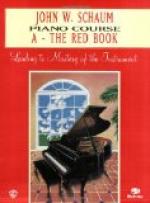“I am often questioned on the subject of memorizing. Some pupils think if they play the piece a sufficient number of times they will know it; then are troubled because they cannot at all times remember the notes. Such players must know every note of the piece away from the piano, and be able to recite them. I have students who are able to learn their music away from the instrument, and can play it to me without having tried it on the piano. I require the piece so thoroughly memorized that if I correct a measure or phrase, the pupil can go right on from that point, without being obliged to start farther back, or at the beginning. In some cases, however, if the pupil has her own method of committing to memory, and it is successful, I have no desire to change it.
OCTAVE STUDIES
“For octave study, form the hand with the ’octave grimace,’—that is with arched hand, the unemployed fingers slightly curved. In staccato touch of course use light wrist. Begin with one beat in sixteenths and finish with the ‘wiping off’ touch. Build up more and more beats in notes of the same value, always ending the passage with the same touch, as above mentioned. This exercise can be played the full length of the keyboard, in all keys, and also chromatically. It can be played in the same fashion, using four-voiced chords instead of octaves. When such an exercise can be prolonged for twenty minutes at a time, octave passages in pieces have no terrors for the pianist. For the octaves in Chopin’s Polonaise Op. 53, he would merely have to learn the notes, which can be done away from the piano; there is no need for exhaustive practise of the passage.
KEEPING UP REPERTOIRE
“In order to keep repertoire in repair, one should have it arranged so that old pieces are gone over once a week. Group your repertoire into sections and programs. It might be well to begin the week with Chopin, playing through the whole list; after which pick out the weak places, and practise those. Tuesday, take Schumann, and treat him in the same way. Then comes Liszt, Russian music, modern composers, concertos, and chamber music. In this systematic way the whole repertoire is kept up.
DETAILS OF PRACTISE
“My mornings are given up to practise, my afternoons to teaching. Of these practise hours, at least one hour is given to technic, scales, arpeggios, octaves, chords—and Bach! I believe in taking one selection of Bach, say a Two-voiced Invention, and perfecting it, playing it in various ways—transposing it into all keys and polishing it to the highest degree possible. The B flat Invention is a useful one for this treatment. So with etudes; instead of playing at so many, is it not better to perfect a few and bring them up to the highest degree of completeness?




